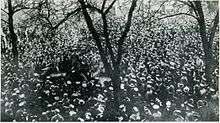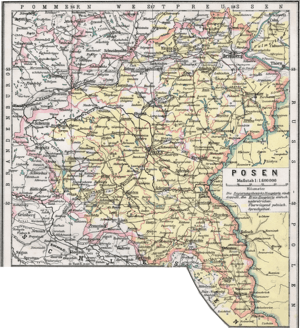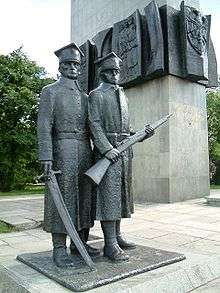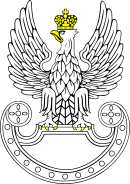Greater Poland uprising (1918–1919)
| Territorial evolution of Poland in the 20th century |
|---|
|
Post World War II |
|
Areas
|
|
Demarcation lines
|
|
Adjacent countries |
The Greater Poland uprising of 1918–1919, or Wielkopolska uprising of 1918–1919 (Polish: powstanie wielkopolskie 1918–19 roku; German: Großpolnischer Aufstand) or Posnanian War was a military insurrection of Poles in the Greater Poland region (German: Grand Duchy of Poznań or Provinz Posen) against German rule. The uprising had a significant effect on the Treaty of Versailles, which granted a reconstituted Second Polish Republic the area won by the Polish insurrectionists. The region was part of the Polish-Lithuanian Commonwealth before the Second Partition of Poland in 1793 when it was taken over by the German Kingdom of Prussia.
Background

After the Third Partition of Poland in 1795, the Polish nation had ceased to exist as an independent state. From 1795 through the beginning of World War I, several unsuccessful uprisings to regain independence took place. A 1806 uprising was followed by the creation of the Duchy of Warsaw which lasted for eight years before being partitioned again between Prussia and Russia. Under the oppressive German rule Poles faced systematic discrimination and oppression.[1][2][3] The Poles living in the region of Greater Poland were subjected to Germanisation and land confiscations to make way for German colonization.
At the end of World War I, United States President Woodrow Wilson's Fourteen Points and the idea of national self-determination were met with opposition from European powers standing to lose influence or territory—this included Germany and its domination of Greater Poland. German politicians had signed an armistice leading to a ceasefire on 11 November 1918. Also, Germany had signed the Treaty of Brest-Litovsk with the Bolshevik Russia to settle the territorial boundaries of the eastern frontiers. The Brest-Litovsk treaty did not take into consideration a future Polish state, therefore from the date that the armistice was signed until the Treaty of Versailles was fully ratified in January 1920, many of the territorial and sovereignty issues remained unresolved.
Wilson's proposal for an independent Poland initially did not set borders that could be universally accepted. Most of Poland that was partitioned and annexed to Prussia in the late 18th-century was still part of greater Germany at the close of World War I, with the rest of the subsequent post–World War I Polish territory being part of Russia and of Austria-Hungary. The portion which was part of Germany included the region of Greater Poland, of which Poznań (Posen) was a major industrial city and its capital. The majority of the population was Polish (more than 60%)[4] and hoped that they would be repatriated within the borders of the new Polish state.
Uprising


In late 1918, Poles with hopes for a sovereign Poland started serious preparations for an uprising after Kaiser Wilhelm's abdication on 9 November 1918, which marked the end of the German monarchy and empire, which would be replaced by the Weimar Republic.
The uprising broke out on 27 December 1918 in Poznań, after a patriotic speech by Ignacy Paderewski, the famous pianist, who would become the Polish prime minister in 1919.
The insurrectionist forces consisted of members of the Polish Military Organization, who formed the Straż Obywatelska (Citizen's Guard), later renamed as Straż Ludowa (People's Guard), which included many volunteers, who were mainly veterans of World War I. The first contingent to reach the Bazar Hotel, from where the uprising was initiated, was a 100-strong force from wildecka kompania Straży Ludowej (Wilda’s People’s Guard) led by Antoni Wysocki. The ruling body was the Naczelna Rada Ludowa (Supreme People's Council). Initially, the members of the Council, including Captain Stanisław Taczak and General Józef Dowbor-Muśnicki were against an uprising, but changed their minds in support of the insurrection on 9 January 1919.
The timing of the uprising was advantageous for the insurrectionists, as between late 1918 and early 1919, internal conflict had weakened Germany, and many of the soldiers and sailors engaged in mutinous actions against the German state. Demoralized by the signing of an armistice on 11 November 1918, the new German government was further embroiled in subduing the German Revolution.
By 15 January 1919, the Poles took control of most of the province, and engaged in heavy fighting with the regular German army and irregular units such as the Grenzschutz. The fighting continued up until the renewal of truce between the Entente and Germany on 16 February. The truce also affected the front line in Greater Poland, but despite the ceasefire, skirmishes continued until the final signing of the Treaty of Versailles on 28 June 1919.
The Greater Poland Uprising is one of the two most successful Polish uprisings, the other was the Great Poland Uprising of 1806 that ended with the entry of Napoleon's army on the side of the Poles fighting against Prussia.
Many of the Greater Poland insurrectionists later took part in the Silesian Uprisings against German rule, which started in late 1919 and ended in 1921.
Reaction

The uprising had a significant effect on the decisions in Versailles that granted Poland not only the area won by the insurrectionists, but the lands of the Polish Corridor, which were also part of the Polish-Lithuanian Commonwealth before the First Partition of Poland in 1772, thus connecting the country to the Baltic Sea. Some of the major cities included Bydgoszcz (Bromberg), Leszno (Lissa), as well as Rawicz (Rawitsch). The riots initiated by the minority German population later influenced the decision to have popular votes in Silesia, where the public was allowed to vote whether it wanted to be part of Poland or Germany.
Germany's territorial losses following the Treaty of Versailles incited German revanchism,[5] and created unresolved problems such that the status of the independent Free City of Danzig and the Polish Corridor between East Prussia and the rest of Germany. Attending to these issues was part of Adolf Hitler's political platform. Throughout the 1920s and 1930s, Poland refused several German proposals for popular referendums, population transfers, highway projects and customs union reforms, fearing an eventual land grab from Germany.
Timeline
Earlier events

- January 1916: creation of Secret Inter-Party Citizen's Committee (pl. Tajny Międzypartyjny Komitet Obywatelski) formed by members of the German Reichstag of Polish nationality.
- July 1918: a network of local Citizens' Committees is created on area of Prussian Partition.
- 11 October 1918: Polish organizations in the German Empire publicize common documents in which they declare the will to create independent Polish state; in effect, revolution.
- 9 November 1918: beginning of the German Revolution, which also occurred in Greater Poland. Poles organized secret military structures in the Poznań garrison, Jarocin and Inowrocław.
- 10 November 1918: events of the so-called Republika Ostrowska.
- 11 November 1918
- Armistice signed, ending hostilities of World War I.
- The Citizens' Guard (Straż Obywatelska), renamed a few days later to The People's Guard (Straż Ludowa) comes out from the underground. The Mayor of Poznań (Posen) Ernst Wilms is removed from office. German military authorities give permission for functioning of the People's Guard to keep peace in the Province of Posen.
- 12 November 1918
- The Central Citizen's Committee, later renamed to the Supreme People's Council (Naczelna Rada Ludowa, NRL), creates temporary "government-in-waiting"—Commission (Komisariat): Stanisław Adamski, Wojciech Korfanty, and Adam Poszwiński.
- Jarogniew Drwęski becomes the Mayor of Poznań.
- 13 November 1918
- Commission of the High People's Council calls citizens of German portion of Poland to keep calm in spite of the revolution.
- "Assassination on City Hall": as it was dominated by Germans, the Execution Department of Worker's and Soldier's Council proceeded to Poznań's City Hall, an armed group of Poles forced them to change four of the German Delegates with Poles: Bohdan Hulewicz, Mieczysław Paluch, Henryk Śniegocki and Zygmunt Wiza. Due to this event, Poles gain control over the headquarters of Poznań Garrison and 5th Corps.
- 17 November 1918: Commission of NRL calls for a one-time collection of money called a "national tax".
- 18 November 1918: elections to Poviat's People's Councils and members of the Partition's Sejm (1399 MPs).
- 20 November 1918: in exposé of the Polish government in Warsaw: przyłączenie Wielkopolski będzie jednym z pierwszych naszych zadań (the joining of Greater Poland will be one of our first tasks).
- 3 December 1918: The Partition Sejm of Poznań began official proceedings, in building of the "Apollo" Cinema. MPs were representing all lands of the Prussian Partition and Polish economic emigration, mainly from Westfalen.
- 5 December 1918: end of the Partition Sejm, which declared its desire for unification with the other partitions in a renationalized Poland and with NRL officially electing its members.
- 6 December 1918: first meeting of the NRL elected. Bolesław Krysiewicz becomes a Speaker. Election of executive body—Commission of NRL formed by representatives of: Greater Poland - Stanisław Adamski and Władysław Seyda; Upper Silesia: Wojciech Korfanty and Józef Rymer; Eastern Pomerania: Stefan Łaszewski; Kuyavia: Adam Poszwiński.
- 11 December 1918: Polish language and teaching of religion in Polish returns to schools.
- 15 December 1918: Polish government in Warsaw breaks diplomatic relations with Germany.
Uprising

- 27 December 1918: evening: uprising starts with shooting in front of Poznań's Police Headquarters. Fighting also start in other towns: Szamotuły, Środa Wielkopolska, Pniewy, Opalenica, Buk, Trzemeszno, Września and Gniezno are captured. Poles in Poznań capture the main train station, Main Post Office and part of city fortifications.
- 28 December 1918
- Poles in Poznań capture Cytadela (a main stronghold), Fort Grolmann and an armory on ul. Wielkie Garbary
- Commission of NRL promotes Captain Stanisław Taczak to temporary Commander-in-Chief of the uprising (he is also promoted to rank of major).
- 29 December 1918: Poles capture Grodzisk Wielkopolski, Kłecko, Kórnik, Wielichowo, Gostyń, Witkowo and other towns.
- 30 December 1918
- Failure of peace talks between the insurgents and the German authorities, the latter refusing to take the responsibility for hostilities of 27 December.
- In Poznań Poles force German 6th Regiment of Grenadiers from their barracks. After talks, Regiment leaves the city with their weapons.
- Poles capture of Wronki, Wągrowiec, Gołańcz. Polish soldiers stop German offensive against Gniezno near Zdziechowa.
- 31 December 1918
- Poles capture Kościan, Oborniki Wielkopolskie, Ostrów Wielkopolski.
- Unit of Poles under command of Paweł Cymes begins offensive on Cuiavia.
- 1 January 1919
- 3 January 1919: to avoid anarchy in Greater Poland, the Committee of NRL decides to take over control of spontaneous uprising, but also decides that this decision should be kept secret.
- 4 January 1919: Commission of NRL decrees new President of the Province of Poznań, Wojciech Trąmpczyński. German authorities call for boycott of new President.
- 5 January 1919: Czarnków, Jutrosin, Kruszwica, Nakło, Nowy Tomyśl, Miejska Górka, Rawicz, Strzelno and Wolsztyn are captured by the Poles.
- 6 January 1919
- Poles capture Ławica Airport in Poznań with all aircraft undamaged.
- Fighting near Czersk and Kościerzyna in Pomerania.
- Inowrocław captured.
- 7 January 1919
- 8 January 1919
- Commission of NRL takes all civil and military authority without declaring territorial range of this power. It also promotes General Józef Dowbor-Muśnicki to commander-in-chief of uprising forces.
- Poles recapture Chodzież (Battle of Chodzież) and Czarnków. They also win Battle of Ślesin and capture Sieraków.
- 9 January 1919
- NRL officially announces taking control over Greater Poland. Beginning of polonisation of administration, most former anti-Polish officials are fired. In powiats, German landrats are subordinated to Polish starostas, which in future takes all their power.
- Poles lose Nakło.
- Polish airmen bomb military airfield in Frankfurt (Oder)
- 10 January 1919: fights on southern front near Kąkolewo, Leszno and Rydzyna. Poles capture Sarnowa.
- 11 January 1919: Germans recapture Sarnowa and win in Battle of Zbąszyń; Polish victory in Battle of Szubin and capture Łabiszyn, Złotniki and Żnin.
- 12 January 1919: fights near Leszno and Lipno.
- 13 January 1919: Germans recapture Szamocin.
- 14 January 1919: Commission of NRL appeals to Roman Dmowski for help on negotiation of ceasefire.
- 15 January 1919: failed attempt to recapture Szamocin by Poles.
- 16 January 1919
- First number of Tygodnik Urzędowy Naczelnej Rady Ludowej with laws of NRL is published.
- In central Polish government of Ignacy Paderewski are two politicians of Greater Poland: Józef Englich - minister of treasury and Kazimierz Hącia - minister of industry and trade.
- 17 January 1919: Men born in years 1897, 1898, and 1899 are called up and drafted into Great Polish Army.
- 20 January 1919: transfer of money to banks of the German Reich on other side of front line is forbidden.
- 21 January 1919
- NRL creates oath of soldiers of Great Polish Army.
- Evidence of false information about Polish attacks on German civilians published by authorities in Berlin, suggesting behavior like that of Germans themselves, is sent to Paris. Contemporaneously, the NRL appeals to Allies asking for a military mission, suggesting the possibility of the Great Polish Army fighting against Bolsheviks. Many articles about the situation in Greater Poland appear in Western newspapers.
- 22 January 1919
- Northern front: Poles are forced to leave Potulice.
- Southern front: Poles win Battle of Robaczysko.
- Joseph Noules is nominated by Highest Council of Allied Countries as chief of Allied mission in Poland.
- 23 January 1919: Poles defend Miejska Górka after heavy fighting.
- 25 January 1919
- 26 January 1919: Soldiers of Great Polish Army with commander Dowbór-Muśnicki give oath on Wilhelm Platz, renamed on Plac Wolności (Freedom Square) in Poznań.
- 28 January 1919: German offensive in area of Bydgoszcz and Nakło. Battle of Rynarzewo. Germans capture Szubin.
- 29 January 1919: Roman Dmowski gives speech in front of Highest Council of Allied Countries in which he asserts Polish rights to the Prussian Partition, and accusing Germans of two-faced policies.
- 2 February 1919: beginning of Polish-German talks in Berlin.
- 3 February 1919: Poles stop German offensive on northern front. Their counterattack forces German withdrawal to northern bank of Noteć river. Poles recapture Rynarzewo and win Battle of Kcynia.
- 4 February 1919
- 5 February 1919: Failure of talks in Berlin. German conditions were: demobilisation of Great Polish Army, recognition by Poland of German claims to Greater Poland and payment by Polish side for all damage made during uprising. In spite of this, Entente still remarks that both sides are ready for peace talks.
- 6 February 1919: end of talks about representation of Prussian Partition in Sejm Ustawodawczy. With regard to fact that Greater Poland, Cuiavia, Silesia and Pomerania are still officially part of Reich, to avoid international repercussions, Polish government and NRL decide to resign from planned election of 126 MPs, giving temporary right of representation of Prussian Partition to 16 MPs of Reichstag.
- 7 February 1919
- Heavy fighting in Kolno, which was captured many times by both sides.
- Commission of NRL promotes 122 former NCOs of German Army to rank of Second Lieutenant.
- Chief of state Józef Piłsudski signs decree officially allowing 16 MPs from Prussian Partition to participate in Sejm Ustawodawczy.
- 9 February 1919: Poles stop German offensive near Trzciel.
- 10 February 1919: Poles stop German attack near Rawicz.
- 11 February 1919: Commission of NRL dissolves all town councils, giving 25 March as date of elections of new self-governments.
- 12 February 1919: Germans use armoured train to capture Kargowa and Babimost, but their offensive is stopped near Kopanica.
- 14 February 1919
- 16 February 1919: prolongation of Allied-German ceasefire in Trier is signed, which also referred to front in Greater Poland. Contemporary Greater Poland Army is recognized as Allied Forces.
Between ceasefire and reunification

- 18 February 1919: In spite of ceasefire, there is fighting near Rynarzewo. Poles capture armoured train.
- 9 February 1919: Volunteer company of Great Polish soldiers moves to Lesser Poland to fight against Ukrainians.
- 20 March 1919: Ostmarkenzulage—special allowance for German officials working in eastern provinces, which aimed to stimulate German colonization of Prussian Partition, is canceled.
- 23 March 1919: Poles win landslide in election of City Council of Poznań.
- 24 March 1919: Commission of NRL ask Polish Government in Warsaw to create separate administration of ex-Prussian Partition, as it is far more developed than rest of the country. Ignacy Paderewski forces government to leave all power in hands of NRL in those lands till final recognition of Polish-German border, and in future creation of autonomy of those lands (after all only Upper Silesia received it). NRL mobilises men born in 1891, 1892, 1893, 1894 and 1901.
- 5 April 1919: Sejm Ustawodawczy announces by-elections in ex-Province of Posen for next 42 MPs.
- 9 April 1919: Commission of NRL decrees 8-hour workday in industry and trade.
- 10 April 1919: Commission of NRL decrees removing all signs in German language from offices and train stations, and changes all streets names into Polish. Punishment for breaking this law was two years of prison and 10,000 Polish marks.
- 16 April 1919: NRL decides that 3 May will be national holiday.
- 7 May 1919: Wszechnica Piastowska is opened.
- 15 May 1919: Polish language becomes only official language. German language is only auxiliary, but a lack of Polish speaking officials means German is still used in judiciary till 1920.
- 25 May 1919: Army of Great Poland is subjugated to Headquarters of Polish Army, but keeps its separate organisation.
- 30 May 1919: People's Guard is transformed to Home Defence (Obrona Krajowa).
- 1 June 1919: by-elections of MPs to Sejm Ustawodawczy.
- 6 June 1919
- Skirmishing near Bydgoszcz (Bromberg).
- Rising threat of German offensive induces Commission of NRL to introduce state of emergency in all lands under its jurisdiction, and in a belt of 20 km from the front line it introduces martial law. A few days later, NRL announces penalty of death for acting against Great Polish Army or in interest of German Army.
- 18 June 1919: Skirminshing near Rynarzewo.
- 28 June 1919: Treaty of Versailles gives almost all of Great Poland to Poland.
- 1 July 1919
- Commission of NRL removes customs border with ex-Kingdom of Poland.
- Artillery fire at front.
- 9 July 1919: outside of 20 km belt near front, state of emergency is canceled.
- 10 July 1919: proceedings of Polish Government with whole Commission of NRL about further policy in Former Prussian Partition (Były Zabór Pruski). Decision taken about creation of Ministry of Former Prussian Partition (Ministerstwo Byłej Dzielnicy Pruskiej).
- 1 August 1919: Sejm Ustawodawczy votes on resolution about "Temporary organisation of government in former Prussian Partition" (O tymczasowej organizacji zarządu byłej dzielnicy pruskiej), creating Ministry of Former Prussian Partition and plan of gradual unification of Great Poland with rest of country.
- 12 August 1919: Władysław Seyda becomes first Minister of Former Prussian Partition.
- 19 August 1919: NRL is dissolved.
- 28 August 1919: Headquarters of Polish Army issues daily order No. 216 in which Great Polish Army is amalgamated with Polish Army, and its Headquarters are transformed to Headquarters of 7th Corps.
- 6 November 1919: Commission of NRL is dissolved.
- 10 January 1920: ratification of Treaty of Versailles, according to which Polish forces in Great Poland should take control over small pieces of Great Poland's territories given to Poland that are resisting under German control and Eastern Pomerania.
- 13 January 1920: Headquarters of Great Poland front issues orders for preparation of implementation of Treaty of Versailles.
- 17 January 1920: beginning of occupation of remaining German held territories assigned to Poland under Versailles treaty.
- 8 March 1920: Great Poland front dissolved.
Epilogue
- 24 March 2005: the last surviving Polish fighter in the uprising, Lieutenant Jan Rzepa, died at the age of 106.
References
- ↑ Racisms Made in Germany edited by Wulf D. Hund, Wulf Dietmar Hund, Christian Koller, Moshe Zimmermann LIT Verlag Münster 2011 page 20, 21
- ↑ The Ideology of Kokugo: Nationalizing Language in Modern Japan, Lee Yeounsuk page 161 University of Hawaii Press 2009
- ↑ The Immigrant Threat: The Integration of Old and New Migrants in Western Europe since 1850 (Studies of World Migrations) Leo Lucassen page 61 University of Illinois Press page 2005
- ↑ "Historia 1871–1939" Anna Radziwiłł, Wojciech Roszkowski Warsaw 1998
- ↑ Boemeke, Manfred F.; Feldman, Gerald D.; Gläser, Elisabeth, eds. (1998). The Treaty of Versailles: A Reassessment After 75 Years. Publications of the German Historical Institute. Cambridge University Press. p. 220. ISBN 0521621321.
Bibliography
- Antoni Czubiński, Powstanie Wielkopolskie 1918–1919. Geneza-charakter-znaczenie, Poznań 1978
- Antoni Czubiński, Rola Powstania Wielkopolskiego w walce narodu polskiego o powstrzymanie niemieckiego >parcia na wschód<, Przegląd Zachodni 1968, nr 5-6
- A.Czubiński, Z.Grot, B.Miśkiiewcz, Powstanie Wielkopolskie 1918–1919. Zarys dziejów, Warszawa 1978
- K.Dembski, Wielkopolska w początkach II Rzeczypospolitej. Zagadnienia prawno-ustrojowe, Poznań 1972
- Roman Dmowski, Polityka polska i odbudowanie państwa 1925
- Z. Grot (ed.), Powstanie wielkopolskie 1918–1919, Poznań 1968
- Z.Grot, I.Pawłowski, M.Pirko, Wielkopolska w walce o niepodległość 1918–1919. Wojskowe i polityczne aspekty Powstania Wielkopolskiego, Warszawa 1968
- P.Hauser, Niemcy wobec sprawy polskiej X 1918–VI 1919, Poznań 1984
- K.Kandziora, Działalność POW w Poznaniu. Przyczynek do historii Polskiej Organizacji Wojskowej zaboru pruskiego w latach 1918–1919, Warszawa 1939
- S.Kubiak, Niemcy a Wielkopolska 1918–1919, Poznań 1969
- Joseph Lamia: Der Aufstand in Posen (The Uprising in Poznan). Berlin 1919 (in German).
- Materiały Sesji Naukowej z okazji 50-lecia Powstania Wielkopolskiego 1918/1919, Zaszyty Naukowe UAM 1970, Historia t.10
- Witold Mazurczak, Anglicy i wybuch powstania wielkopolskiego. Z dziejów genezy brytyjskiej misji płka H.H.Wade'a w Polsce, [in:] Antoni Czubiński (ed.), Polacy i Niemcy. Dziesięć wieków sąsiedztwa, PWN, Warszawa 1987
- Janusz Pajewski, Rodział XXII. Powstanie Wielkopolskie, [in:] J.Pajewski, Odbudowa państwa polskiego 1914–1918, Warszawa 1985,
- Janusz Pajewski, Znaczenia Powstania Wielkopolskiego dla odbudowy Państwa Polskiego w 1918 r., Zeszyty Naukowe UAM, Historia 1970, t.10
- S.Rybka, Zerwane pęta. Wspomnienia z dni rewolucji niemieckiej i powstania polskiego 1918-1919, Poznań 1919
- A.Rzepecki, Powstanie grudniowe w Wielkopolsce. 27 XII 1918, Poznań 1919
- Z.Wieliczka, Wielkopolska w Prusy w dobie powstania 1918/1919, Poznań 1932
- Z.Wroniak, Paderewski w Poznaniu, Kronika Miasta Poznania 1959, nr 4
- H.Zieliński, Rola powstania wielkopolskiego oraz powstań śląskich w walce o zjednoczenie ziem zachodnich z Polską; (1918–1921), [in:] Droga przez Półwiecze.
- Dietrich Vogt: Der großpolnische Aufstand 1918/1919: Bericht, Erinnerungen, Dokumente. Marburg 1980 (J.-G.-Herder-Institut) ISBN 3-87969-147-9
- Richard Blanke, Orphans of Versailles. The Germans in Western Poland 1918-1939, Lexington, KY.,1993 (presents somehow pro-German vision of the events)
External links
-
 Media related to Wielkopolskie Uprising 1918-1919 at Wikimedia Commons
Media related to Wielkopolskie Uprising 1918-1919 at Wikimedia Commons




